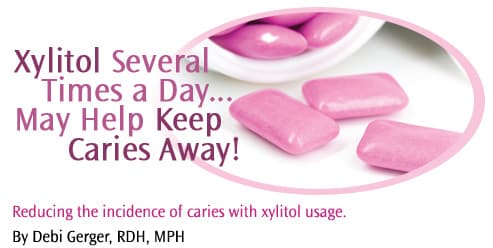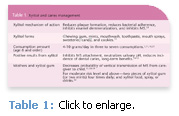
Xylitol Several Times a Day… May Help Keep Caries Away!
Reducing the incidence of caries with xylitol usage.
Xylitol has been used in health care since the early 1960s, but it has gained recent attention in the dental community because of its practical applications in caries management. The Turku Sugar Studies from the University of Turku, Finland, were the first to discuss the dental benefits of xylitol and they continue to provide information about the relationship between dental plaque and xylitol consumption in adolescent and teenage populations.1-3 The initial Turku Sugar Studies conducted in 1970 demonstrated that the incidence of decayed, missing, and filled teeth decreased with the consumption of xylitol gum.4 Today, xylitol is commercially available as a noncariogenic sugar substitute with the potential to reduce caries rates by inhibiting Mutans streptococci growth.1-2
CARIES PROCESS AND RISK ASSESSMENT STEPS
The caries balance concept describes the need to manage the pathological, risk factors, and protective factors of caries.5-7 For determining caries risk assessment, the pathological (disease) indicators include white spots on smooth surfaces, restorations placed in the previous 3 years, radiographic approximal enamel lesions, and visible lesions or radiographic penetration of the dentin.7 Risk factors or biological predisposing factors include moderate to high culture levels of Mutans streptococci (MS) and lactobacilli (LB), visible heavy plaque, frequent snacks, deep pits and fissures, recreational drug use, inadequate saliva flow, saliva reduction factors (medication/radiation/systemic), exposed roots, and orthodontic appliances.7 Protective factors include multiple sources of fluoride at home/work/school, fluoride toothpaste, fluoride mouthrinse, fluoride varnish, office fluoride application, chlorhexidine, xylitol gum or lozenges, calcium/phosphate products, and adequate saliva flow.7
After considering these factors, the next step is to determine the patient’s caries risk level.7 The American Academy of Pediatric Dentistry Caries-Risk Assessment Tool (CAT) and the Caries Management by Risk Assessment (CAMBRA) approach are both designed to asses risk level. The CAT was developed to aid dental and nondental health care providers in assessing risk levels for caries development and consists of three parts: patient history through a caregiver interview, clinical evaluation, and a supplemental professional assessment with radiographs and microbiological testing.8 The CAMBRA approach provides caries risk assessment through disease indicators, risk factors, and protective factors to determine the associated clinical protocols or interventions.7,9
MANAGING DENTAL CARIES
At-home recommendations for the management of dental caries that are age- and risk level-dependent include daily oral hygiene with fluoridated toothpaste that is over-the-counter (1,000 to 1,100 ppm fluoride) or prescription (5,000 ppm fluoride); over-the-counter fluoride mouthrinse (0.05% sodium fluoride) or prescription (0.2% sodium fluoride); consumption of fluoridated drinking water; antibacterials such as chlorhexidine (chlorhexidine gluconate 0.12% with 11.6% alcohol); xylitol-containing products such as chewing gum and candy; and buffering products for pH control with an acid-neutralizing rinse and/or baking soda gum.11-12
In-office recommendations include frequent recare visits and radiographs; saliva testing to determine saliva flow and/or bacterial challenge; professionally applied topical fluorides such as foams and sodium fluoride (NaF) varnishes to inhibit plaque bacteria and demineralization while enhancing remineralization; sealant placement; topical application of 10% povidone-iodine as an effective antimicrobial agent against both MS and LB in children (additional studies are needed to determine effectiveness in older children and adults); paste or particulates to deliver calcium and phosphate to the enamel for possible remineralization; and new products to detect and treat dental caries.11-12
XYLITOL FOR CARIES MANAGEMENT
Tooth decay affects more than a quarter of American children aged 2 to 5 and half of those aged 12 to 15.10 In fact, tooth decay is the most common chronic disease of childhood at a rate five times greater than asthma.14-15 Tooth decay can afflict people of all ages, cultures, and socioeconomic levels but is particularly severe in young children who live in poverty as well as minorities and those in poor health.14
Dental caries is an infectious, transmissible biofilm disease that results in tooth destruction from pathologic microorganisms where the enamel is demineralized in an acidic pH environment.5 Enamel dissolution occurs when the pH of the oral solutions, such as saliva and dental plaque fluids, becomes more acidic than the enamel critical pH.16 The critical pH for enamel varies between 5.1 and 6.5 based on the levels of calcium and phosphate such that higher levels of calcium and phosphate lower the critical pH of enamel.16
Caries management with the use of xylitol decreases the amount of MS and raises the salivary pH level because MS is unable to metabolize xylitol and xylitol inhibits the attachment of MS to teeth.10-11 Systematic or regular patient use of xylitol with respect to caries risk level and higher dosage and frequency of xylitol consumption may lower MS levels and the incidence of dental caries.10-11,17 Xylitol containing products such as chewing gum may also be an effective approach to decrease the probability of vertical transmission of MS from mother to child.11,18-19
SOURCES OF XYLITOL
 Xylitol, a five-carbon sugar alcohol derived from forest and agricultural materials, has been used since the early 1960s in infusion therapy and in diabetic foods.20 Finnish researchers recognized the dental benefits of xylitol in animals in 1970, which led to the development of the first chewing gum in 1975.20 Dental implications for xylitol include decreasing the incidence of dental caries, arresting carious lesions, and decreasing the vertical transmission of MS from mothers and caregivers to children.11
Xylitol, a five-carbon sugar alcohol derived from forest and agricultural materials, has been used since the early 1960s in infusion therapy and in diabetic foods.20 Finnish researchers recognized the dental benefits of xylitol in animals in 1970, which led to the development of the first chewing gum in 1975.20 Dental implications for xylitol include decreasing the incidence of dental caries, arresting carious lesions, and decreasing the vertical transmission of MS from mothers and caregivers to children.11
Commercially available xylitol is from birch trees and other hardwoods as well as fruits and vegetables.10 Xylitol is found in products such as chewing gum, mints, mouthwash, toothpaste, mouth sprays, sweetener, candy, and cookies.11 Studies suggest positive results with daily xylitol taken three to seven times per day for a total intake of 4-10 grams for ages 6 through adulthood.1,11,10,21 Products need to be used multiple times per day depending on the quantity of xylitol in each dose.10
Patients should be instructed to look for products where xylitol is listed as the first ingredient and/or contact the manufacturer to determine the amount of xylitol in the product.11 Xylitol usage by a parent or caregiver should begin 3 months after delivery and until the child is 2 years of age.18,20 The parent or caregiver regimen is two sticks of xylitol chewing gum or two mints four times daily as well as xylitol food, spray, and drinks.22 Lasting effects have been demonstrated up to 5 years after 2 years of using xylitol chewing gum.18 In large quantities (over four to five times the recommended consumption), diarrhea can result.10 Additionally, xylitol is not indicated for pets, especially dogs.22
CONCLUSIONS
Xylitol, in conjunction with additional in-office treatment and at-home regimens, is part of an overall caries management plan based on the patient’s caries risk assessment (see Table 1). Consideration of the caries balance concept brings the focus of the clinician to the patient’s pathological, risk, and protective factors to determine the appropriate recommendations.7 The next step in preventing dental decay is twofold—clinicians providing education about the benefits of xylitol and manufacturers producing clearly labeled xylitol-containing products.
REFERENCES
- Mäkinen KK, Bennett CA, Hujoel PP, Isokangas PJ, Isotupa KP, Pape HR Jr, Mäkinen PL. Xylitol chewing gums and caries rates: a 40-month cohort study. J Dent Res. 1995;74:1904-1913.
- Mäkinen KK, Saag M, Isotupa KP, Olak J, Nõmmela R, Söderling E, Mäkinen PL. Similarity of the effects of erythritol and xylitol on some risk factors of dental caries. Caries Res. 2005;39:207-215.
- Mäkinen KK, Alanen P, Isokangas P, et al. Thirty-nine-month xylitol chewing-gum programme in initially 8-year-old school children: a feasibility study focusing on mutans streptococci and lactobacilli. Int Dent J. 2008;58:41-50.
- Scheinin A, Mäkinen KK, Ylitalo K. Turku sugar studies. V. Final report on the effect of sucrose, fructose and xylitol diets on caries incidence in man. Acta Odontol Scand. 1976;34:179-216.
- Featherstone JD. Caries prevention and reversal based on the caries balance. Pediatr Dent. 2006;28:128-132.
- Featherstone JD. Delivery challenges for fluoride, chlorhexidine, and xylitol. BMC Oral Health. 2006;6(Supp 1): S8.
- Featherstone JDB, Domejean-Orliaguet S, Jenson L, Wolff M, Young DA. Caries risk assessment in practice for age 6 through adult. J Calif Dent Assoc. 2007;35:703-713.
- American Academy of Pediatric Dentistry. Policy on use of a caries-risk assessment tool (CAT) for infants, children, and adolescents. Oral Health Policies Reference Manual. 2007;29(7):29-33.
- Featherstone JD, Adair SM, Anderson MH, et al. Caries management by risk assessment: consensus statement, April 2002. J Calif Dent Assoc. 2003; 31(3):257-269.
- Lynch H, Milgrom P. Xylitol and dental caries: an overview for clinicians. J Calif Dent Assoc. 2003;31(3):205-209.
- Spolsky VW, Black BP, Jenson L. Products: old, new, and emerging. J Calif Dent Assoc. 2007;35(10):724-737.
- Jenson L, Budenz AW, Featherstone JD, Ramos-Gomez FJ, Spolsky VW, Young DA. Clinical protocols for caries management by risk assessment. J Calif Dent Assoc. 2007;35(10):714-723.
- U.S. Department of Health and Human services. Oral health: preventing cavities, gum disease, and tooth loss. (CDC Publication No. CS 110431), April 2007. Available at: www.cdc.gov/nccdphp/publications/aag/pdf/oh.pdf.
- dela Cruz GG, Rozier RG, Slade G. Dental screening and referral of young children by pediatric primary care providers. Pediatrics. 2004;114:e642-e652.
- Mouradian WE, Wehr E, Crall JJ. Disparities in children’s oral health and access to dental care. JAMA. 2000;284(20):2625-2631.
- Dawes C. What is the critical pH and why does a tooth dissolve in acid? J Can Dent Assoc. 2003;69(11):722-724.
- Ly KA, Milgrom P, Roberts MC, Yamaguchi DK, Rothen M, Mueller G. Linear response of mutans streptococci to increasing frequency of xylitol chewing gum use: a randomized controlled trail. BMC Oral Health. 2006;6:1-6.
- Soderling E, Isokangas P, Pienihakkinen K, Tenovuo J, Alanen P. Influence of maternal xylitol consumption on mother-child transmission of mutans streptococci: 6 year follow-up. Caries Res. 2001;35(3):173-177.
- Thorild I, Lindau B, Twetman S. Caries in 4-year-old children after maternal chewing of gums containing combinations xylitol, sorbitol, chlorhexidine and fluoride. Eur Arch Paediatr Dent. 2006;7(4):251-245.
- American Academy of Pediatric Dentistry. Policy on the use of xylitol in caries prevention. Oral Health Policies Reference Manual. 2007;29(7):36-37.
- Milgrom P, Ly KA, Roberts M, Rothen M, Mueller G, Yamaguchi DK. Mutans Streptococci dose response to xylitol chewing gum. J Dent Res. 2006;85(2):177-181.
- Ramos-Gomez FJ, Crall J, Gansky SA, Slayton RL, Featherstone JD. Caries risk assessment appropriate for the age 1 visit (infants and toddlers). J Calif Dent Assoc. 2007;35(10):687-702.
From Dimensions of Dental Hygiene. July;6(7): 28, 30.

